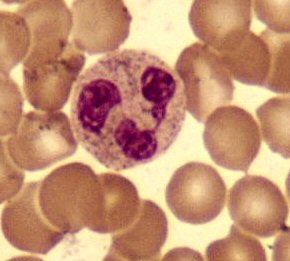White blood cells abnormalities
From WikiLectures
Neutrophil abnormalities[edit | edit source]
Quantitative deviations[edit | edit source]
The reduced number of neutrophils is called neutropenia, granulocytopenia. If the number drops below 0,5 · 109/l we speak aboutagranulocytosis.
- Causes
- Toxic bone marrow damage – treatment with cytostatics, after radiotherapy, if the bone marrow bone marrow is infiltrated by tumour cells.
- Cyklic neutropenia – (genetically determined).
- Inefficient proliferation – cytostatics, etc.
- Increased peripheral utilization – cytolysis after repeated transfusions, autoimmune neutropenia at SLE, accumulation in the inflammatory locus.
- Pseudoneutropenia – e.g. at splenomegaly.
The increased number is referred to as neutrophilia up to leukemoid reaction.
- Causes
- Increased need for neutrophils – inflammation, sepsis.
- Hemoblastosis.
- Hypoxia.
- Stress, cold, heat.
- Pharmacologically – hydrocortisone.
- Decreased tissue withdrawal – chronic use of glucocorticoids.
- Chronic bone marrow stimulation – chronic inflammation, bone metastases.
Qualitative deviations[edit | edit source]
- Chediak-Higashi syndrome – albinism, increased susceptibility to infections, morphological abnormalities of blood cells (alterations of phagocytosis + intracellular killing of microorganisms).
- Chronic granulomatous disease – a genetic disease of childhood, in which neutrophils lack the necessary oxidative mechanisms → infections with the formation of microabscesses and granulomas.
- LAD syndrome (leukocyte adhesion deficiency) – a disorder of adhesion to the endothelium and subsequent migration, frequent pyogenic infections without pus formation.
Eosinophil abnormalities[edit | edit source]
- Eozinopenia – acute infections, stress, hypercorticism, corticoids - has no clinical significance.
- Eosinophilia – parasitic infections (most often toxocara canis, ascaridiasis, taeniasis, less trichinella spiralis), skin diseases (eczemas, psoriasis, urticaria, pemphigus), allergic diseases (asthma bronchiale, granulomas, lung infiltrates), malignant tumours (Hodgkin's tumour, Grawitz tumour), idiopathic hypereosinophilic syndrome, scarlatina, osinophilic gastroenteritis, eosinophilic fascitidis, polyarteritis nodosa, vasculitis, hypocorticism, eosinophilic leukaemia.
Basophil deviations[edit | edit source]
- Basophilia – myxoedema, myeloproliferation (especially chronic myeloid leukaemia and polycythaemia vera), basophilic leukaemia, myelodysplasia.
- Basopenia – hyperthyroidism, hypercorticism.
Lymphocyte abnormalities[edit | edit source]
- Lymphocytopenia – Wiskott-Aldrich syndrome, terminal stages of carcinomas, advanced Hodgkin's disease, after radio- and chemotherapy, after glucocorticoid treatment, immunodeficiencies such as hypogammaglobulinemia and agammaglobulinemia, collagenases, AIDS, Whipple's disease, tuberkulosis, sarkoidosis, renal failure, rentgen irradiation.
- Lymphocytosis – relative in granulocytopenia (see above), absolute mainly in viral infection (infectious mononucleosis, cytomegaly, toxoplasmosis), lymphoproliferative diseases (low malignant lymphomas, Sézary's syndrome - cutaneous lymphoma accompanied by erythroderma, Hodgkin's disease, chronic lymphadenosis, thyreotoxikosis, bacterial infections (TBC, pertussis).
Monocyte abnormalities[edit | edit source]
- Monocytopenia – trichocellular leukaemia, glucocorticoid therapy.
- Monocytosis – infections (infectious endocarditis, TBC, syphilis), sarkoidosis, leishmaniasis, malaria, brucellosis, SLE, RA, PAN, ulcerative colitis, Crohn's disease, drug toxicity (hydantoinates), myelomonocytic leukaemia, some carcinomas (especially stomach, mamma, ovaries), in infectious mononucleosis is rather an increase in atypical lymphocytes; storage diseases (disorder of the monocyte-macrophage system).
Links[edit | edit source]
Related articles[edit | edit source]
- Laboratory examination of cellular immunity
- B-lymphocytes
- T-lymphocytes
- Neutrophils
- Basophils
- Eosinophile
- Macrophages
- Phagocytosis
References[edit | edit source]
- KLENER, P, et al. Vnitřní lékařství. 3. edition. Praha : Galén, 2006. ISBN 80-7262-430-X.
- KRČ, Ivo. Hodnocení bílého krevního obrazu v ambulantní praxi. Interní medicína pro praxi [online]. 2004, y. 6, vol. 3, p. 144–146, Available from <http://www.internimedicina.cz/pdfs/int/2004/03/09.pdf>. ISSN 1803-5256.

